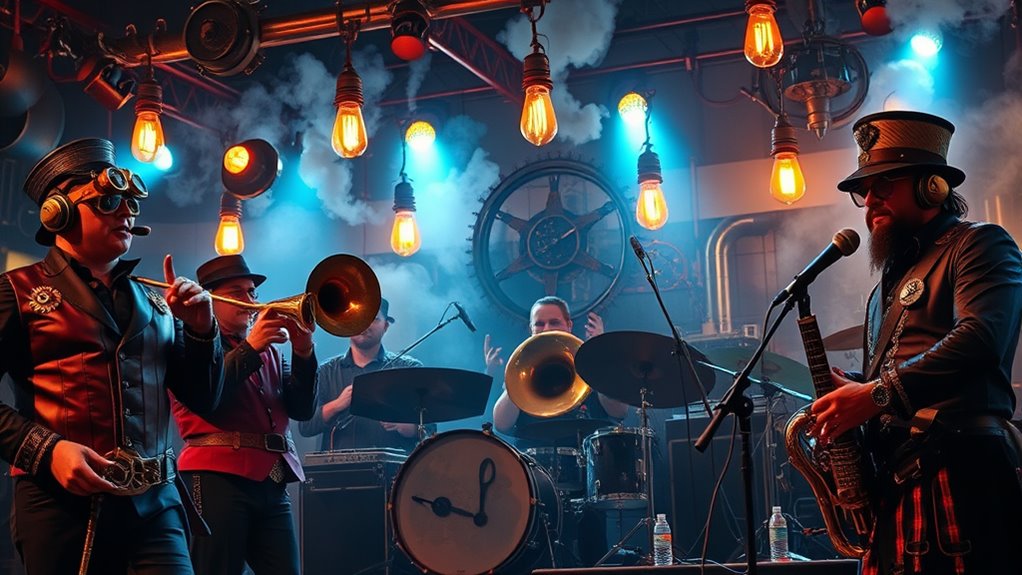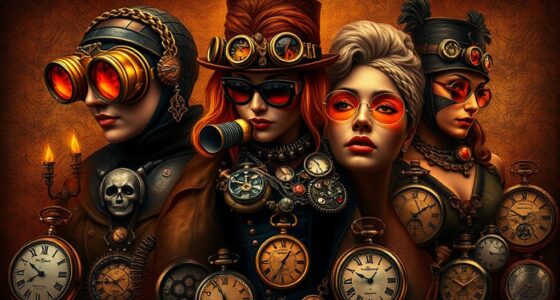Steampunk music combines Victorian elegance with industrial sounds, creating a unique blend of vintage-inspired and futuristic tones. Bands like Abney Park, Steam Powered Giraffe, and The Cog is Dead incorporate orchestral, electronic, and mechanical noises that evoke a sense of adventure and invention. Performers often wear Victorian costumes to enhance the immersive experience. If you want to explore the influence of craftsmanship, machinery, and nostalgia in this genre, keep exploring for more fascinating details.
Key Takeaways
- Steampunk music blends Victorian elegance with industrial sounds, incorporating orchestral, electronic, and mechanical elements for a nostalgic yet futuristic vibe.
- Bands like Abney Park and The Cog is Dead exemplify Victorian-inspired costumes and storytelling through mechanical soundscapes.
- The genre features a mix of vintage instruments, modern technology, and industrial noises to create immersive, thematic compositions.
- It celebrates craftsmanship, invention, and exploration, evoking images of steam-powered inventions and uncharted worlds.
- Steampunk genres often fuse folk, industrial, and dark ambient styles to craft a unique auditory adventure blending past and future.

Have you ever wondered what it sounds like when Victorian aesthetics meet modern musical innovation? If you’re curious, steampunk music offers a fascinating blend of the old and new. This genre draws heavily on Victorian aesthetics, which means you’ll notice a focus on intricate details, vintage fashion, and a sense of nostalgia for the 19th century. But what sets steampunk apart is its incorporation of industrial sounds—clanking gears, buzzing machinery, and metallic clangs—that evoke the era’s technological advancements. When these elements combine, you get a rich tapestry of music that feels both historical and futuristic at once.
Listening to steampunk music, you might feel transported to a world where steam-powered inventions and Victorian elegance coexist. The genre often features orchestral arrangements that include brass, strings, and classical instruments, layered with mechanical noises and electronic effects that mimic industrial machinery. This fusion of Victorian aesthetics and industrial sounds creates a distinct atmosphere, giving you a sense of adventure, innovation, and a touch of steampunk fantasy. It’s like hearing the hum of a clockwork city or the whir of an automaton come to life through music.
Many bands and artists have embraced this style, crafting their sound around these themes. You’ll find groups that use vintage instruments combined with modern technology, producing a sound that’s both nostalgic and cutting-edge. These artists often wear Victorian-inspired costumes during performances, emphasizing the aesthetic aspect and immersing you further into the genre’s world. The use of industrial sounds isn’t just for effect; it’s integral to the storytelling, symbolizing the relentless march of progress and the mechanical heartbeat of steampunk society.
The appeal of steampunk music lies in its ability to evoke a specific mood—one of curiosity, ingenuity, and a desire to explore uncharted worlds. It invites you to imagine a universe where Victorian beauty and industrial innovation coexist seamlessly. Whether you’re drawn to the visual style, the storytelling, or the experimental soundscapes, this genre offers a unique sonic experience that challenges the boundaries of traditional music. As you explore steampunk, you’ll discover a genre that celebrates craftsmanship, invention, and a timeless fascination with the mechanical age, all wrapped into a captivating auditory adventure.
Frequently Asked Questions
How Did Steampunk Music Originate Historically?
You’ll find steampunk music originated from a blend of Victorian aesthetics and Industrial sounds in the late 20th century. Artists drew inspiration from the Victorian era’s elegance and technological innovation, combining it with gritty, mechanical noises. This fusion created a unique genre that celebrates retro-futurism and alternative history. As a result, steampunk music evolved into a distinctive style, reflecting both nostalgia and forward-looking creativity rooted in historical and industrial influences.
Are There Specific Instruments Unique to Steampunk Bands?
Think of steampunk bands as musical inventors, crafting their sound with Victorian instrumentation and brass ensembles that echo a bygone era. While no instrument is exclusive to steampunk, they often favor vintage-looking gear like brass horns, steam-powered calliopes, and ornate mechanical percussion. These elements blend Victorian elegance with industrial grit, creating a soundscape that transports you to a steampunk universe. Your experience becomes a journey through gears and steam, alive with vintage charm.
How Does Steampunk Music Influence Fashion and Art?
Steampunk music influences your fashion and art by blending Victorian aesthetics with industrial motifs. As you embrace this style, you’ll see how the music’s themes inspire intricate costumes, often featuring gears, goggles, and corsets. Art becomes more nostalgic and mechanical, reflecting the genre’s love for vintage elegance and industrial grit. This fusion encourages creativity, making your wardrobe and artwork a visual tribute to a fantastical, steampunk-inspired world.
Can Steampunk Music Be Mixed With Other Genres?
Absolutely, you can mix steampunk music with other genres—who said it has to stay in its Victorian corner? Fusion genres and genre blending are your best friends here, creating quirky, eclectic sounds that defy convention. Imagine steampunk beats mashed up with electronic, jazz, or rock—it’s like Victorian goggles meet futuristic synths. So go ahead, break the mold and craft a unique sonic adventure that’s as inventive as steampunk fashion!
What Are Upcoming Steampunk Music Festivals or Events?
You can look forward to upcoming steampunk events like the Steamposium and the Victorian Steampunk Festival, which showcase vibrant performances and immersive experiences. These steampunk music festivals often feature live bands, costume contests, and art displays, creating a lively atmosphere. Keep an eye on local event calendars and social media for the latest updates on upcoming steampunk events, so you won’t miss any of the exciting performances and community gatherings.
Conclusion
Now that you’ve explored the world of steampunk music, you see how it blends Victorian aesthetics with modern innovation. From the energetic bands to the atmospheric genres, it’s a genre that invites imagination and creativity. So, why not immerse yourself further and discover your own favorite steampunk sound? With so much variety, isn’t it about time you let this unique genre inspire your musical journey? plunge in and let your curiosity lead the way!









